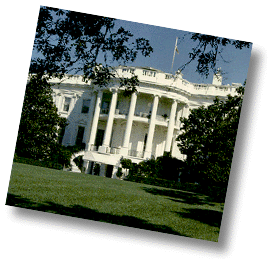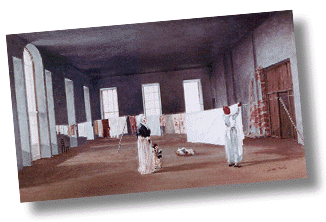
The White House is unique among the residences of world leaders. It is simple yet stately, elegant yet informal, a private home and a working office. But it didn't start out that way. The smoothly functioning White House you can visit today bears little resemblance to the mansion first occupied by President Adams in 1800. |
 |
 lthough John Adams (1797-1801) was
our second President, he was the first to live in the White House. When
he moved into the building in 1800, it was barely finished. In fact, the plaster on the inside walls
was still wet! The Grand Staircase was not even begun, wood shavings and
carpenter tools littered the shell of clay bricks that was the East Room,
and Mrs. Adams' letters tell us that clotheslines were strung up
in its vast emptiness. During their stay, the house
stayed shivering cold, and its windows rattled against the strong northwest winds.
The President's wife, Abigail, even had to seek enough firewood to heat the rooms. lthough John Adams (1797-1801) was
our second President, he was the first to live in the White House. When
he moved into the building in 1800, it was barely finished. In fact, the plaster on the inside walls
was still wet! The Grand Staircase was not even begun, wood shavings and
carpenter tools littered the shell of clay bricks that was the East Room,
and Mrs. Adams' letters tell us that clotheslines were strung up
in its vast emptiness. During their stay, the house
stayed shivering cold, and its windows rattled against the strong northwest winds.
The President's wife, Abigail, even had to seek enough firewood to heat the rooms.
Over the years, the White House slowly evolved into the stately residence we know today. Each First Family left a legacy to the next and influenced the historic period they each, in turn, represented. The changes made to the White House as each President and First Lady added their own stamp have been more than architectural and decorative -- they have also affected the mansion's staffing and management. President William Howard Taft (1909-1913) hired a housekeeper, Elizabeth Jaffrey, who became a familiar sight throughout Washington, traveling by horse-drawn carriage to do the marketing for the First Family. She bought butter by the tub, potatoes by the barrel, fruit and fresh vegetables by the crate. Henrietta Nesbitt came to the White House as chief housekeeper during Franklin Delano Roosevelt's Administration (1933-1945), charged with supervising the maintenance of 60 rooms and 20 bathrooms (today the White House has 132 rooms and 32 bathrooms). For years she oversaw the cleaning of the immense chandeliers in the East Room. Workmen stood on specially built trestles to care for each of the 22,000 separate pieces of glass. The prisms were removed, one at a time, washed, polished, and hung back in place. This job was done once a year, just before the formal social season began, and took six men a full week to finish. Because of the large number of people visiting the building, simply keeping the White House clean was a major undertaking. Throughout the 1930s and 1940s, the ground floor was scrubbed every morning and mopped as needed during the day. The linen covers on the chairs had to be changed each day. One man was assigned to take care of the Grand Staircase alone. Starting at the top of the stairs, he would dust his way down to the bottom -- and then began working his way up once more. Meanwhile, painters, carpenters, electricians, and plumbers were constantly at work. Others kept busy by washing the 160 windows, skylights, and mirrors, dusting furniture, polishing the brasswork and silver, cleaning the hearths, and setting out flowers throughout the mansion. If you would like to learn more about this subject, you may want to read the book we used as a reference in preparing this newsletter: The President's House, by William Seale.
|
[Back to Fall 97] | [Back to Previous Issues]
